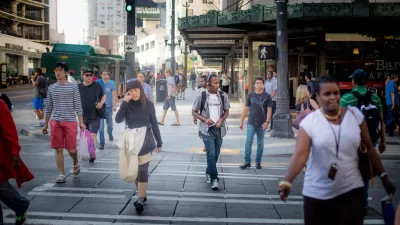Following up on earlier reports about the latest commuting data from the U.S. Census 2013 American Community Survey, Joseph Kane and Adie Tomer find different trends in commute choice between age groups.
"By and large, millennials and Generation X are leading the charge toward a range of alternate modes, including public transportation and walking, while baby boomers continue to use their cars at high levels," report Joseph Kane and Adie Tomer.
Some of the key findings of their analysis (there's a lot more and more info on the implications of the data in the article):
- "…workers ages 16 to 24—the youngest working millennials—are commuting the least by car compared to all other age groups (82.4 percent), a share that has fallen by nearly 1.3 percentage points in large metro areas since 2007 alone."
- "Young millennials also represent the commuters who most frequently take public transportation (5.8 percent) and walk to work (6.6). They’re not only ditching the car in traditional multimodal hubs like San Francisco, but in several smaller metros as well."
- "Unlike these two age groups, baby boomers aged 55 and up are the only commuters to consistently drive more since 2007."
FULL STORY: Millennials and Generation X Commuting Less by Car, But Will the Trends Hold?

Planetizen Federal Action Tracker
A weekly monitor of how Trump’s orders and actions are impacting planners and planning in America.

Map: Where Senate Republicans Want to Sell Your Public Lands
For public land advocates, the Senate Republicans’ proposal to sell millions of acres of public land in the West is “the biggest fight of their careers.”

Restaurant Patios Were a Pandemic Win — Why Were They so Hard to Keep?
Social distancing requirements and changes in travel patterns prompted cities to pilot new uses for street and sidewalk space. Then it got complicated.

Platform Pilsner: Vancouver Transit Agency Releases... a Beer?
TransLink will receive a portion of every sale of the four-pack.

Toronto Weighs Cheaper Transit, Parking Hikes for Major Events
Special event rates would take effect during large festivals, sports games and concerts to ‘discourage driving, manage congestion and free up space for transit.”

Berlin to Consider Car-Free Zone Larger Than Manhattan
The area bound by the 22-mile Ringbahn would still allow 12 uses of a private automobile per year per person, and several other exemptions.
Urban Design for Planners 1: Software Tools
This six-course series explores essential urban design concepts using open source software and equips planners with the tools they need to participate fully in the urban design process.
Planning for Universal Design
Learn the tools for implementing Universal Design in planning regulations.
Heyer Gruel & Associates PA
JM Goldson LLC
Custer County Colorado
City of Camden Redevelopment Agency
City of Astoria
Transportation Research & Education Center (TREC) at Portland State University
Camden Redevelopment Agency
City of Claremont
Municipality of Princeton (NJ)




























